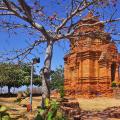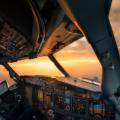Indeed, why shouldn't we, my friends, unwind? And then somehow they stayed too long.
First trip around the world, by Fernand Magellan. It was on the border of optics, scary to say, in 1519-1521. At such a distance, the context and scale of the event are completely lost: what was it then - to go around Earth... Here is the route map:
The first stage of the long journey is logical and already mastered. The boats (according to the official version) are about thirty years old. Further Magellan (he has five ships with a crew of 250 people) turns south. A logical solution. The super task of the trip is to go around "Neindia" and open a direct route to the West. BUT. In 1520, the configuration South America COMPLETELY NOT KNOWN. Even the coast of modern Brazil is Terra Incognita. The mouth of the Amazon has just been opened. No one knows where it ends New World... Let's take the point of view of Magellan. It descends to the mouth of La Plata. It is a colossal hydrographic junction, a base for internal colonization and for the construction of first-class seaports. JACK POT True, it is believed that the mouth of the La Plata was discovered by the Spanish conquistador Juan Diaz de Solis in 1516. I will not argue. It is important that he was killed by the Indians along with the entire crew and the discovery remained "a thing in itself." La Plata was reopened by Cabot in 1527. However, he did not hear anything about Magellan (why, more on that below).
So, karramba, America stretches and stretches. SHE IS HUGE. But on the other hand THIS is good. Very good. Why should the devils break into India when breathtaking panoramas of new lands open under their noses. Every day, the declared goal of Magellan becomes more and more ephemeral, but the real result of the expedition is more and more significant. What would happen if Magellan's expedition actually took place? The scales would gradually outweigh and somewhere in the area of La Plata the moment of truth would come. ENOUGH. We turn back - for honors and awards. They opened new lands for the crown, received unique materials about the configuration of the new continent. Cabot did just that. But the stubborn Magellan goes on and on. Way down.
I admit that in case of exceptional obstinacy, Magellan could reach Tierra del Fuego or Cape Horn. Where it is cold (for a southerner it is very cold), and a gusty wind constantly roars. It is simply dangerous to go further. On fragile boats, with a tired crew, AFTER THE RISE AND THE CRASH OF ONE OF THE SHIPS, Magellan turns into the future Strait of Magellan. The Strait of Magellan is the moment when Stanislavsky must shout his “I don’t believe” from the audience. But this is just the beginning. The expedition passes an incredibly difficult strait (giant monthly surfing between rocks with a strong current and constant fog), turns along coastline to the north, swims for some time and - this is a fantasy - departs from the rich and unknown coast to nowhere. V open ocean.
Further. People who believe that the world's oceans are teeming with fish are very naive. The ocean is a biological desert. The fish is found only near the shores, in shallow waters. In extreme cases, on seasonal migration routes. The area where Magellan sailed after turning from South America to the West is the ZONE OF DEATH. At the beginning of the 19th century, North American whalers (that is, PROFI) got into one of these zones. The result is massive cannibalism. First, they ate the corpses of the dead, then switched to fresh meat. In the story of Magellan's journey, it is described how for four months people ate bread dust mixed with worms, drank rotten water, ate cowhide, sawdust and ship rats. At the same time, on the three remaining vessels, very small, by the end of the voyage through Pacific Ocean(this is half the planet, and even sailed DIAGONALLY) 140 people remained. These are not only sailors, but also passenger-soldiers.
And that is not all. After the death of Magellan and 24 crew members in the open Philippines (for some reason, named by the Spaniards in honor of the king who ascended the throne much later), the expedition plots a route in the southern, deserted and completely unexplored areas of the Indian Ocean. And nothing. FINISHED.
In this regard, it is reasonable to ask the question: when was the SECOND trip around the world? It turns out that in 1577-1580, that is, half a century later. Here is the scale of the fantastic journey of Magellan.
And that's not quite. Who made the second trip around the world? The character of the English state mythology Francis Drake. Anyone who reads Drake's biography with cotton in his ears (so as not to hear the screams of British commissioners) will quickly be convinced that this is literary character like Baron Munchausen. That only is the story of the sinking of the Great Armada by Drake. In reality, Drake was a small piece, one of the first English pirates who hunted not in northern Europe, but in the Atlantic. Drake got the Spaniards, Spain declared war on England. The British grimaced for a while, then on their knees they wept forgiveness from Great Spain, reimbursing all the losses. The scale of then Spain and then England is the scale modern USA and modern Mexico. Drake is believed to have robbed coastal towns Latin America and, to avoid meeting the Spanish fleet, crossed the Pacific and Indian oceans, circled Africa and returned to England. Not really what circumnavigation, and even sailing from America to Asia across the Pacific Ocean was considered certain death. In reality, the Spaniards were slowly probing the Pacific Ocean, relying on their ports on west coast America. The probe was very unsuccessful, with a lot of losses. Data on open lands in the Pacific Ocean were classified. The British received them only in the middle of the 18th century, after the capture of Manila as part of the Seven Years War. The Spaniards have classified them, tk. feared that the coordinates of the islands would be used by pirates, as well as by the French and British. Apart from the Philippines, the Spaniards did not colonize anything - all the islands were small things.
The real development of the Pacific Ocean by the British and French is the 18th century. At the same time there were the first round-the-world travels. Formally, several round-the-world travels of the Englishman William Dempir can be considered somewhat plausible. This is the end of the 17th century. The travels turned out by themselves, were described in the style of "count yourself" and to a certain extent were the fruit of the author's outstanding literary abilities. The concept of a round the world travel arose in the era of the Anglo-French state horse riding of Bougainville and Cook. This is the second half of the 18th century. Subsequently, Austria, Russia (since 1803), etc., joined the state sport.
Now back to Magellan. WHERE? Everything is very simple. In the second half of the 18th century, the concept of "circumnavigation" was invented; in the second half of the 18th century, one should look for the origins of Magellanomania. It turns out that the entire journey of Magellan in the smallest details of the novel's quest was described by a member of the expedition Pigafetta. BUT. Pigafetta's notes remain in the manuscript. And they forgot about Magellan, with his amazing, even incredible journey. Finally, a manuscript of one copy was found in Italy and published. In ... 1800. In the 19th century, Pigafetta's essay became a European bestseller, and in the 20th it went a jamb of Stefan Zweig.
An interesting man found Pigafetta's manuscript. Serious. Carlo Amoretti. Remember the manuscripts of the overthrowing rage, the Grand Master Leonardo da Vinci? Blueprints of planes, submarines, tanks? Everything is at the level of engineering fantasies of the late 18th and early 19th centuries. HE. Published after Pigafetta in Milan in 1804.
In fact, the historian of the "Magellans" should be drowned at the very beginning, like blind kittens. Otherwise, until the end of life until real story you won't get there. I traveled here for fun, and the puncture of the legend at the very beginning. The Spanish expedition, having crossed the Atlantic, was supposed to go to the Spanish port. Refuel with food, fix the tackle. And the main thing is to check in in front of a local official.
Main -> Encyclopedia ->Magellan made the first trip around the world. Everyone knows that. And who made the second round the world trip?
1577-1580 - the second trip around the world under the command of the Englishman Francis Drake (galleon "Golden Hind").An English navigator and corsair of the time of Elizabeth I. The first Englishman to circumnavigate the world (1577-1580) Defeated the Spanish fleet (Invincible Armada) in the Battle of Graveline in 1588. Owned the Buckland-Abbey estate in Yelverton.
In 1577, Drake was sent by Queen Elizabeth on an expedition to the Pacific coast of America. The official purpose of the trip was to discover new lands, in particular Australia. Francis embarked on this voyage in the 100-ton flagship Pelican, accompanied by four more ships. Without entering the Strait of Magellan, Drake was the first to go around Tierra del Fuego, thereby finding out that it is not part of the southern continent (although Drake's primacy is disputed). The wide strait between Tierra del Fuego and Antarctica now bears his name.
After the flagship "Pelican" was the only one of all ships "made his way" to the Pacific Ocean, it was renamed the "Golden Hind". Drake marched along the Pacific coast, attacking Spanish ports such as Valparaiso, and explored the coast well north of the Spanish colonies, as far as present-day Vancouver. On June 17, 1579, Drake landed, it is assumed, in the San Francisco area (according to another hypothesis, in modern Oregon) and declared this coast an English possession ("New Albion").
After resupply and repairs, Drake crossed the Pacific Ocean to the Moluccas. Bypassing Africa, Drake returned to England in September 1580. For this expedition, Drake was awarded a knighthood.
Question answer
It was the time when ships were built of wood,
and the people who ruled them were forged from steel
Ask anyone, and he will tell you that the first person to travel around the world was the Portuguese navigator and explorer Ferdinand Magellan, who died on the island of Mactan (Philippines) during an armed clash with the natives (1521). The same is written in history textbooks. In fact, this is a myth. After all, it turns out that one excludes the other. Magellan managed to go only half the way.
Primus circumdedisti me (you were the first to go around me) - reads the Latin inscription on the coat of arms crowned with a globe Juan Sebastian Elcano. Indeed, Elcano was the first person to sail around the world.
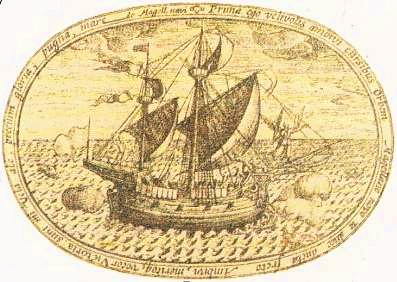
In the San Telmo Museum of the city of San Sebastian there is a painting by Salaverria "The Return of Victoria". Eighteen emaciated people in white shrouds, with lighted candles in their hands, staggered down the ladder from the ship to the embankment of Seville. These are sailors from the only ship that returned to Spain from the entire Magellan flotilla. Ahead is their captain, Juan Sebastian Elcano.
Much in Elcano's biography has not yet been clarified. Oddly enough, the man who circled the globe for the first time did not attract the attention of artists and historians of his time. There is not even a reliable portrait of him, and from the documents he wrote, only letters to the king, petitions and will have survived.
Juan Sebastian Elcano was born in 1486 in Getaria, a small port town in the Basque Country, near San Sebastian. He early connected his own fate with the sea, making a career that was not uncommon for an enterprising person of that time - first changing his job as a fisherman for a smuggler's share, and later enlisting in the navy to avoid punishment for his too free attitude to laws and trade duties. Elcano managed to take part in the Italian Wars and the Spanish military campaign in Algeria in 1509. Basque mastered the maritime business well in practice when he was a smuggler, but it is in the navy that Elcano receives the "correct" education in the field of navigation and astronomy.
In 1510 Elcano, owner and captain of the ship, participated in the siege of Tripoli. But the Spanish treasury refused to pay Elcano the amount owed for settlements with the crew. After leaving military service, which never seriously seduced the young adventurer with low earnings and the need to observe discipline, Elcano decides to start a new life in Seville. It seems to Bascu that a brilliant future awaits him - in a new city for him, no one knows about his not entirely flawless past, the navigator atoned for his guilt before the law in battles with the enemies of Spain, he has official papers that allow him to work as a captain on a merchant ship ... But the trade enterprises, of which Elcano becomes a member, turn out to be all unprofitable.
In 1517, in order to pay off debts, he sold the ship under his command to the Genoese bankers - and this trading operation determined his entire fate. The fact is that the owner of the sold ship was not Elcano himself, but the Spanish crown, and the Basque is expected to again have difficulties with the law, this time threatening him death penalty, at that time it was considered a serious crime. Knowing that the court would not take any excuses into account, Elcano fled to Seville, where it was easy to get lost, and then take refuge on any ship: in those days, captains were least interested in the biographies of their people. In addition, there were many Elcano countrymen in Seville, and one of them, Ibarolla, was well acquainted with Magellan. He helped Elcano to enlist in Magellan's flotilla. Having passed the exams and received beans as a sign of a good mark (those who did not pass received peas from the examination committee), Elcano became the helmsman of the third largest ship in the flotilla, the Concepcion.
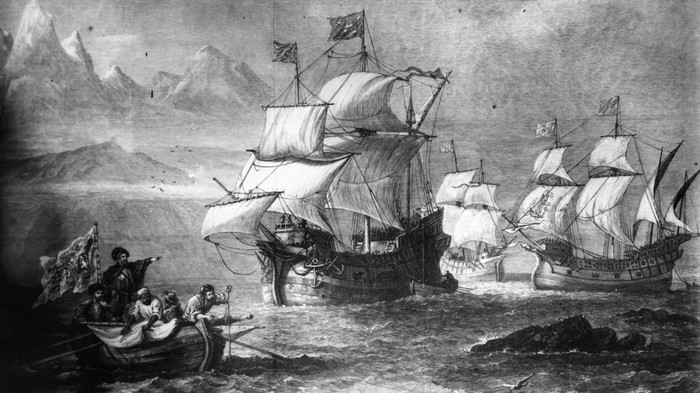
Magellan's flotilla ships
On September 20, 1519, Magellan's flotilla left the mouth of the Guadalquivir and headed for the shores of Brazil. In April 1520, when the ships settled for the winter in the frosty and deserted bay of San Julian, the captains dissatisfied with Magellan revolted. Elcano found himself drawn into it, not daring to disobey his commander, Captain of the Concepcion Quesada.
Magellan vigorously and brutally suppressed the rebellion: Quesade and another of the leaders of the conspiracy were cut off their heads, the corpses were quartered and the mutilated remains were stumbled on poles. Captain Cartagena and one priest, also the instigator of the rebellion, Magellan ordered to land on the deserted coast of the bay, where they later died. The remaining forty rioters, including Elcano, were spared by Magellan.
1. The first ever voyage around the world
On November 28, 1520, the remaining three ships left the strait and in March 1521, after an unprecedentedly difficult passage across the Pacific Ocean, they approached the islands, later called the Mariana Islands. In the same month, Magellan discovered Philippine Islands, and on April 27, 1521 he died in a skirmish with local residents on the island of Matan. Elcano, struck by scurvy, did not participate in this skirmish. After the death of Magellan, Duarte Barbosa and Juan Serrano were elected captains of the flotilla. At the head of a small detachment, they went ashore to the Raja of Cebu and were cunningly killed. Fate again - for the umpteenth time - spared Elcano. Carvalho became the head of the flotilla. But only 115 people remained on the three ships; many of them are sick. Therefore, "Concepcion" was burned in the strait between the islands of Cebu and Bohol; and his crew was transferred to the other two ships - "Victoria" and "Trinidad". Both ships wandered between the islands for a long time, until, finally, on November 8, 1521, they dropped anchor off the island of Tidore, one of the "Spice Islands" - the Moluccas. Then it was generally decided to continue sailing on one ship - "Victoria", whose captain shortly before that had become Elcano, and "Trinidad" to leave in the Moluccas. And Elcano managed to navigate his worm-eaten ship with a starving crew across the Indian Ocean and along the coast of Africa. A third of the team was killed, about a third was detained by the Portuguese, but still "Victoria" on September 8, 1522 entered the mouth of the Guadalquivir.
It was an unprecedented crossing, unheard of in the history of navigation. Contemporaries wrote that Elcano surpassed King Solomon, the Argonauts and the cunning Odysseus. The first ever voyage around the world has been completed! The king granted the navigator an annual pension of 500 gold ducats and knighted Elcano. The coat of arms assigned to Elcano (since then already del Cano) perpetuated his voyage. The coat of arms featured two cinnamon sticks framed with nutmeg and a carnation, a golden lock topped with a helmet. Above the helmet is a globe with the Latin inscription: "You were the first to go around me." And finally, by a special decree, the king announced Elcano forgiveness for selling the ship to a foreigner. But if it was quite easy to reward and forgive the brave captain, then to resolve everything controversial issues related to the fate of the Moluccas turned out to be more complicated. The Spanish-Portuguese Congress met for a long time, but it was never able to "divide" between the two powerful powers the islands located on the other side of the "earthly apple". And the Spanish government decided not to delay the dispatch of the second expedition to Molucca.
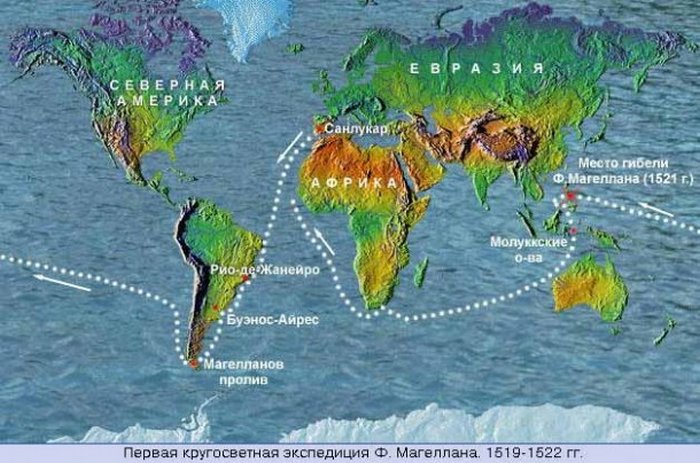
2. Goodbye La Coruna
La Coruña was considered the safest port in Spain, in which "all the fleets of the world could be accommodated." The importance of the city increased even more when the Chamber of Indian Affairs was temporarily transferred here from Seville. This chamber made plans new expedition to the Moluccas in order to finally establish Spanish rule on these islands. Elcano arrived in La Coruña full of bright hopes - he already saw himself as an admiral of the armada - and took up the equipment of the flotilla. However, Charles I did not appoint Elcano as commander, but a certain Jofre de Loais, a participant in many naval battles, but completely unfamiliar with navigation. Elcano's pride was deeply hurt. In addition, from the royal chancellery came "the highest refusal" to Elcano's petition for the payment of an annual pension granted to him of 500 gold ducats: the king ordered that this amount be paid only after returning from the expedition. This is how Elcano experienced traditional ingratitude. spanish crown to the famous sailors.
Before sailing, Elcano visited his native Getaria, where he, a renowned sailor, easily managed to recruit many volunteers on his ships: with a man who walked around the "earthly apple", you will not disappear even with the devil in the mouth - reasoned the port brethren. In the early summer of 1525, Elcano brought his four ships to A Coruña and was appointed helmsman and deputy commander of the flotilla. In total, the flotilla consisted of seven ships and 450 crew members. There were no Portuguese on this expedition. The last night before the departure of the flotilla in La Coruña was very lively and solemn. At midnight on Mount Hercules, on the site of the ruins of a Roman lighthouse, a huge bonfire was lit. The city said goodbye to the sailors. The cries of the townspeople treating the sailors with wine from leather bottles, the weeping of women and the hymns of the pilgrims mingled with the sounds of the merry dance of La Muneira. The sailors of the flotilla remembered this night for a long time. They went to another hemisphere, and now they were faced with a life full of dangers and hardships. For the last time, Elcano walked under the narrow arch of Puerto de San Miguel and descended sixteen pink steps to the shore. These steps, already completely worn out, have survived to this day.
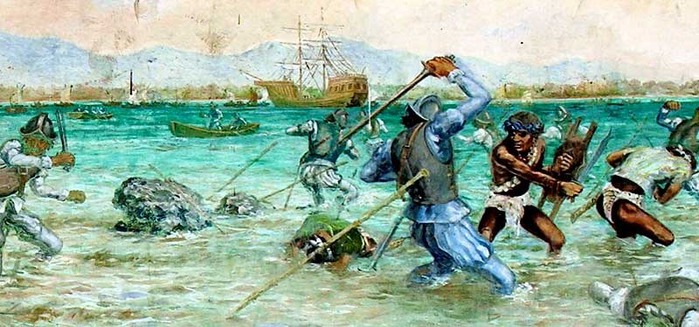
Death of Magellan
3. Misfortunes of the chief helmsman
Loaisa's powerful, well-armed flotilla set out on 24 July 1525. According to royal instructions, and there were fifty-three of them in total, Loaisa had to follow the path of Magellan, but avoid his mistakes. But neither Elcano, the king's chief adviser, nor the king himself foresaw that this would be the last expedition sent through the Strait of Magellan. It was Loaisa's expedition that was destined to prove that this was not the most profitable route. And all subsequent expeditions to Asia were sent from the Pacific ports of New Spain (Mexico).
On July 26, the ships circled Cape Finisterre. On August 18, the ships were caught in a heavy storm. On the admiral's ship, the mainmast was broken, but two carpenters sent by Elcano, risking their lives, still got there in a small boat. While the mast was being repaired, the flagship collided with the Parral, breaking its mizzen mast. The swimming was very difficult. There was not enough fresh water and provisions. Who knows what the fate of the expedition would have been if on October 20 the lookout had not seen Annobon Island in the Gulf of Guinea on the horizon. The island was deserted - only a few skeletons lay under a tree, on which a strange inscription was carved: "Here lies the unfortunate Juan Ruiz, killed because he deserved it." Superstitious sailors saw this as a formidable omen. The ships hastily filled up with water and stocked up on provisions. On this occasion, the captains and officers of the flotilla were summoned to a festive dinner at the admiral's, which almost ended tragically.
A huge fish of an unknown breed was served on the table. According to Urdaneta, Elcano's page and expedition chronicler, some sailors who "tasted the meat of this fish, which had teeth like a big dog, had such a pain in their stomachs that they thought they would not survive." Soon the entire flotilla left the shores of the inhospitable Annobon. From here Loaisa decided to sail to the shores of Brazil. And from that moment on for the "Sancti Espiritus", the ship of Elcano, a streak of misfortunes began. Not having time to set sail, "Sancti Espiritus" almost collided with the admiral's ship, and then generally lagged behind the flotilla for some time. At a latitude of 31º, the admiral's ship disappeared from sight after a violent storm. Elcano assumed command of the remaining ships. Then the San Gabriel separated from the flotilla. The remaining five ships searched for the admiral's ship for three days. The search was unsuccessful, and Elcano ordered to go further, to the Strait of Magellan.
On January 12, the ships stopped at the mouth of the Santa Cruz River, and since neither the admiral's ship nor the San Gabriel approached, Elcano called a council. Knowing from the experience of the previous voyage that there was an excellent anchorage, he suggested waiting for both ships, as it was provided by the instructions. However, the officers, who were eager to enter the strait as soon as possible, advised leaving only the Santiago Pinassa at the mouth of the river, burying a message in the bank under the cross on the island that the ships were heading for the Strait of Magellan. On the morning of January 14, the flotilla weighed anchor. But what Elcano took for the strait turned out to be the mouth of the Gallegos River, five or six miles from the strait. Urdaneta, who despite his admiration for Elcano. retained the ability to treat his decisions critically, writes that such a mistake by Elcano struck him very much. On the same day they came to the real mouth of the strait and anchored at the Cape of the Eleven Thousand Holy Virgins.
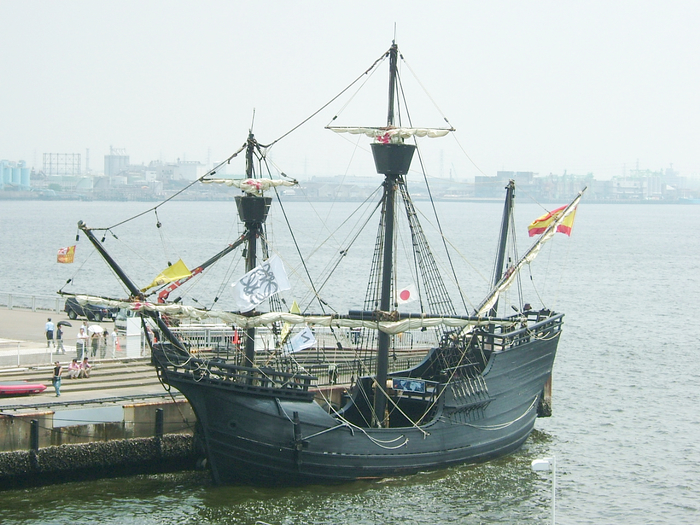
Replica of the ship "Victoria"
At night, a terrible storm hit the flotilla. Raging waves flooded the ship to the middle of the masts, and it barely kept on four anchors. Elcano realized that all was lost. His only thought now was to save the team. He ordered the ship to run aground. Panic broke out on Sancti Espiritus. Several soldiers and sailors threw themselves into the water in terror; all drowned, except for one who managed to reach the shore. Then the rest crossed over to the shore. We managed to save some of the provisions. However, at night the storm broke out with the same force and finally smashed the Sancti Espiritus. For Elcano - the captain, the first circumnavigator and the main helmsman of the expedition - the crash, especially through his fault, was a big blow. Never before has Elcano been in such a difficult situation. When the storm finally subsided, the captains of other ships sent a boat for Elcano, asking him to lead them through the Strait of Magellan, since he had been here before. Elcano agreed, but took only Urdaneta with him. He left the rest of the sailors on the shore ...
But setbacks did not leave the exhausted fleet. From the very beginning, one of the ships almost ran into stones, and only the determination of Elcano saved the ship. After a while, Elcano sent Urdaneta with a group of sailors to fetch the sailors left on the shore. Soon, the Urdaneta group ran out of provisions. At night there was a strong cold, and people were forced to dig up to their throats in the sand, which also warmed a little. On the fourth day, Urdaneta and his companions approached the sailors who were dying from hunger and cold on the coast, and on the same day Loaisa's ship, San Gabriel and the Santiago pinassa entered the mouth of the strait. On January 20, they joined the rest of the ships of the flotilla.
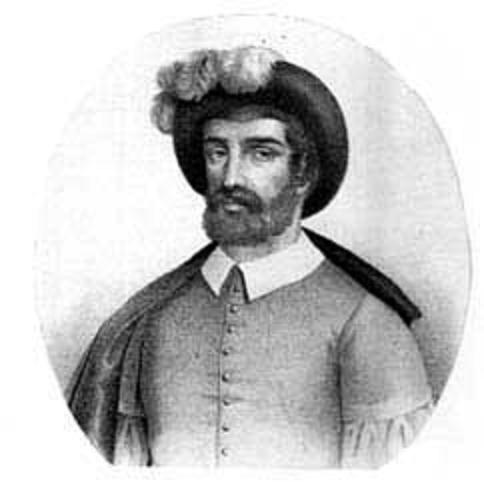
JUAN SEBASTIAN ELCANO
On February 5, a violent storm broke out again. The ship Elcano took refuge in the strait, and the San Lesmes was thrown by the storm further south, to 54 ° 50 ′ south latitude, that is, it approached the very tip of Tierra del Fuego. Not a single ship went further south in those days. A little more, and the expedition could open a path around Cape Horn. After the storm, it turned out that the admiral's ship was aground, and Loaisa and his crew left the ship. Elcano immediately dispatched a group of the best sailors to the admiral's aid. On the same day, Anunciada deserted. The captain of the ship de Vera decided to independently get to Molucca past the cape Good Hope... Anunciada has gone missing. A few days later, San Gabriel also deserted. The remaining ships returned to the mouth of the Santa Cruz River, where the sailors began to repair the admiral's ship, pretty battered by storms. In other conditions, it would have to be abandoned altogether, but now that the flotilla had lost its three largest ships, this could no longer be afforded. Elcano, who, upon his return to Spain, criticized Magellan for staying at the mouth of this river for seven weeks, now himself had to spend five weeks here. At the end of March, the somehow patched up ships again headed for the Strait of Magellan. The expedition now consisted of only an admiral's ship, two caravels and a pinassa.
On April 5, the ships entered the Strait of Magellan. Between the islands of Santa Maria and Santa Magdalena, the admiral's ship suffered another misfortune. A boiler with boiling resin caught fire, a fire broke out on the ship.
Panic began, many sailors rushed to the boat, not paying attention to Loais, who showered them with curses. The fire was still extinguished. The flotilla went further through the strait, along the banks of which on high mountain peaks"So high that they seemed to extend to the very sky," lay the eternal bluish snow. At night, the Patagonians' bonfires burned on both sides of the strait. Elcano already knew these lights from their maiden voyage. On April 25, the ships weighed anchor from the Sao Jorge mooring, where they replenished their supplies of water and firewood, and set off again on a difficult voyage.
And where the waves of both oceans meet with a deafening roar, the storm hit Loaisa's flotilla again. The ships anchored in the bay of San Juan de Portalina. On the coast of the bay were mountains several thousand feet high. It was terribly cold, and “no clothes could warm us,” writes Urdaneta. Elcano was on the flagship all the time: Loaisa, without the appropriate experience, relied entirely on Elcano. The passage through the strait lasted forty-eight days - ten days more than Magellan's. On May 31, a strong north-east wind blew. The whole sky was overcast. On the night from June 1 to June 2, a storm broke out, the most terrible of the former so far, scattering all the ships. Although the weather improved later, they were not destined to meet. Elcano, with most of the Sancti Espiritus crew, was now on the admiral's ship, where there were a hundred and twenty men. Two pumps did not have time to pump out the water, they feared that the ship could sink at any moment. V general ocean was Great, but by no means Quiet.
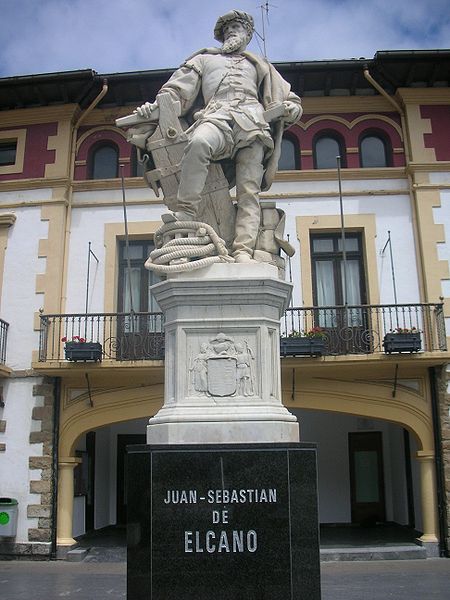
4. The helmsman dies as an admiral
The ship was sailing alone, on the immense horizon neither sails nor islands could be seen. “Every day,” writes Urdaneta, “we waited for the end. Due to the fact that people from the wrecked ship have moved to us, we are forced to reduce the ration. We worked hard and ate little. We had to go through great hardships and some of us died. " Loais passed away on July 30. According to one of the members of the expedition, the cause of his death was a lack of spirit; he was so worried about the loss of the rest of the ships that he "grew weaker and died." Loais did not forget to mention in the will of his chief helmsman: “I ask Elcano to return four barrels of white wine that I owe him. The crackers and other provisions that lie on my ship "Santa Maria de la Victoria", let them give to my nephew Alvaro de Loais, who is to share it with Elcano. " They say that by this time only rats remained on the ship. On the ship, many were sick with scurvy. Wherever Elcano glanced, everywhere he saw puffy pale faces and heard the groans of sailors.
Since the time they left the strait, thirty people have died from scurvy. “They all died,” writes Urdaneta, “because their gums were swollen and they could not eat anything. I saw a man whose gums were so swollen that he tore off pieces of meat as thick as a finger. " The sailors had one hope - Elcano. In spite of everything, they believed in his lucky star, although he was so sick that four days before Loaisa's death he made his will. In honor of Elcano's inauguration as admiral, a position he had unsuccessfully sought two years earlier, a cannon salute was given. But Elcano's strength was running out. The day came when the admiral could no longer get out of bed. His family and loyal Urdaneta gathered in the cabin. In the flickering candlelight, one could see how they were emaciated and how much they suffered. Urdaneta kneels down and touches the body of her dying master with one hand. The priest is watching him closely. Finally he raises his hand, and everyone present slowly kneels. Elcano's wanderings are over ...
“Monday, 6 August. The valiant lord Juan Sebastian de Elcano has passed away. " This is how Urdaneta noted in his diary the death of the great navigator.
Four people lift the body of Juan Sebastian, wrapped in a shroud and tied to a board. At a sign from the new admiral, they throw him into the sea. There was a splash, drowning out the priest's prayers.

MONUMENT IN HONOR OF ELKANO IN GETARIA
Epilogue
Exhausted by worms, tormented by storms and storms, the lone ship continued on its way. The team, according to Urdaneta, “was terribly exhausted and exhausted. Not a day went by without one of us dying.
So we decided that it was best for us to go to the Moluccas. " Thus, they abandoned the bold plan of Elcano, who was going to fulfill Columbus's dream of achieving east coast Asia, following the shortest route from the west. “I am sure that if Elcano had not died, we would not have reached the Ladron (Mariana) Islands so soon, because his always intention was to search for Chipansu (Japan),” writes Urdaneta. He clearly considered Elcano's plan too risky. But the person who circled the “earthly apple” for the first time did not know what fear was. But he also did not know that in three years Charles I would give up his "rights" to Portugal for 350 thousand gold ducats. Of the entire Loaisa expedition, only two ships survived: the San Gabriel, which after a two-year voyage reached Spain, and the Santiago pinassa under the command of Guevara, which passed along the pacific coast South America to Mexico. Although Guevara has only seen the coast of South America once, his voyages proved that the coast does not protrude far to the west anywhere and that South America is triangular in shape. This was the most important geographical discovery Loaisa expeditions.
In Getaria, in the homeland of Elcano, at the entrance to the church there is a stone slab with a half-erased inscription on which reads: “... the glorious captain Juan Sebastian del Cano, a native and resident of the noble and loyal city of Getaria, who was the first to circumnavigate the globe on the ship Victoria. In 1661, Don Pedro de Etave and Hazi, Chevalier of the Order of Calatrava, erected this slab in memory of the hero. Pray for the peace of mind of the one who was the first to travel around the world. " And on the globe in the Museum of San Telmo the place where Elcano died is marked - 157º West longitude and 9º North latitude.
In the history textbooks, Juan Sebastian Elcano undeservedly found himself in the shadow of Fernand Magellan's glory, but at home he is remembered and revered. The name Elcano is a training sailing ship in the Spanish Navy. In the wheelhouse of the ship, you can see the coat of arms of Elcano, and the sailing ship itself has already managed to carry out a dozen round-the-world expeditions.
Sources of
Http://vokrugsveta.com/index.php?option=com_content&task=view&id=551&Itemid=99&limit=1&limitstart=7
Https://www.shtandart.ru/news/news_detail.php?ELEMENT_ID=1752
Http://mirchudes.net/people/762-huan-sebastyan-elkano.html
Nowadays, people go on voyages around the world to test their courage and endurance. And for the first time, round-the-world voyages were set off for quite specific practical purposes - in the interests of trade and navigation. The first circumnavigation of the world was made in the 16th century by the Portuguese aristocrat Fernand Magellan (1480-1521). Prior to that, he led several expeditions looking for trade routes for Portugal, but then fell out with the Portuguese king and entered the service of the Spaniards. They wanted to open trade routes to the East and declare their newly opened possessions, in particular, the Moluccas (Spice Islands). Magellan hoped to reach the Moluccas by traveling west around the southern tip of South America, rather than following the Portuguese trade routes east around Africa (see Vasco da Gamma and the Route to India). Two months after Magellan arrived at the court of the Spanish kings, he received the consent of the young King Charles (later - Emperor Charles V) to finance his expedition.
 In September 1519 Magellan sailed from Spain with an expedition of 260 people on five ships: "Trinidad", "Vittoria", "Santiago", "Concepcion" and "San Antonio". On board the ships were many different goods, but Magellan, who misjudged the duration of the voyage, took too little food with him. The fleet crossed the Atlantic, making a short stop at Canary Islands, and then headed to the shores of Brazil and further along the east coast of South America.
In September 1519 Magellan sailed from Spain with an expedition of 260 people on five ships: "Trinidad", "Vittoria", "Santiago", "Concepcion" and "San Antonio". On board the ships were many different goods, but Magellan, who misjudged the duration of the voyage, took too little food with him. The fleet crossed the Atlantic, making a short stop at Canary Islands, and then headed to the shores of Brazil and further along the east coast of South America.
Mutiny and shipwreck
Magellan faced a bunch of different problems. The weather was so bad that he decided to spend the winter on the coast of what is now called Patagonia. Due to poor food and unbearable cold weather, part of the team rebelled, and Magellan was forced to execute the rebel leaders. Soon the ship "Santiago" was shipwrecked. The rest of the ships managed to find a way to the Pacific Ocean through a narrow strait, which received the name of Magellan. From the ships they noticed bonfires that were burning on south bank locals, and called this land "Terra del Fuego" ( Tierra del Fuego), Strait, discovered by Magellan, made it possible to pave a new path to the East around the southern tip of America.
Disease, hunger, death
Conditions on board were getting worse. The San Antonio team deserted, taking with them most of the expedition's provisions. While sailing across the Pacific Ocean, 20 people starved to death. After replenishing food supplies in the Marshall Islands, the fleet headed for the Philippines. There was a tragedy: Magellan was involved in a war between local princes and was killed along with 40 members of his team.
Magellan's successor
Captain Sebastian del Cano took command of the 115 surviving crew members. With so many sailors, it was impossible to manage three ships, and he decided to leave the Concepcion. Two other ships continued their voyage and in November 1521 reached the Moluccas. Finally, the team was able to buy the coveted spices. To deliver at least some of the cargo home, the ships sailed to Spain on two different routes. "Trinidad" went east towards the Spanish possessions in Panama, but was captured by the Portuguese. Only a few lucky ones from his team managed to escape. The Vittoria sailed west. After passing the trade routes of the Portuguese in Indian Ocean, the ship circled the southern tip of Africa. Escaping captivity, "Vittoria" in 1522 returned to Spain. The vessel spent three years sailing around the world.
Pigafetta's Diary
Italian sailor Antonio Pigafetta took part in the voyage on the Vittoria. We owe most of the information about the travels of Magellan and del Cano to his diary, which he published two years after his return. The diary contains many interesting details about everything that Pigafetta saw on his travels. He first told Europeans about man-eating sharks in the South Atlantic and about a natural electrical phenomenon - St. Elmo's Fire. Pigafetta spoke about the terrible conditions in which the crew lived, about the cold and storms, about the poor food and lack of drinking water, as well as about the inhabitants of the lands visited by the seafarers.
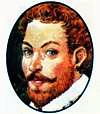 The second in history round-the-world voyage was made by the Englishman Francis Drake (1545-1596). It lasted from 1577 to 1580. In those days, many thought that Tierra del Fuego was part of a huge southern continent called Terra Australis. There were also those who considered Tierra del Fuego an island. Queen Elizabeth I of England sent Drake to the Strait of Magellan to check which of these sentences was true. She also gave him a secret mission to extract as much gold and spices as possible. Both the Queen and Drake, of course, were well aware that such an assignment would allow piracy and could ruin relations between England and Spain. The expedition set off on five ships: Pelican, Merigold, Elizabeth, Swan and Christopher. Drake plundered Spanish ships, mining gold, silver, pearls and emeralds for the queen. Like Magellan, Drake faced many obstacles and unforeseen difficulties while sailing. Storms, hunger and disease caused unrest among the sailors, but Drake suppressed them. He did not find Terra Australis, but did establish that Tierra del Fuego is an island. Drake returned to England on November 3, 1580. Queen Elizabeth visited the navigator aboard the ship and knighted him.
The second in history round-the-world voyage was made by the Englishman Francis Drake (1545-1596). It lasted from 1577 to 1580. In those days, many thought that Tierra del Fuego was part of a huge southern continent called Terra Australis. There were also those who considered Tierra del Fuego an island. Queen Elizabeth I of England sent Drake to the Strait of Magellan to check which of these sentences was true. She also gave him a secret mission to extract as much gold and spices as possible. Both the Queen and Drake, of course, were well aware that such an assignment would allow piracy and could ruin relations between England and Spain. The expedition set off on five ships: Pelican, Merigold, Elizabeth, Swan and Christopher. Drake plundered Spanish ships, mining gold, silver, pearls and emeralds for the queen. Like Magellan, Drake faced many obstacles and unforeseen difficulties while sailing. Storms, hunger and disease caused unrest among the sailors, but Drake suppressed them. He did not find Terra Australis, but did establish that Tierra del Fuego is an island. Drake returned to England on November 3, 1580. Queen Elizabeth visited the navigator aboard the ship and knighted him.

